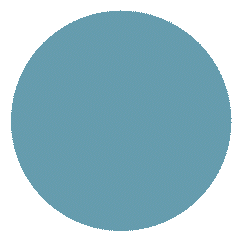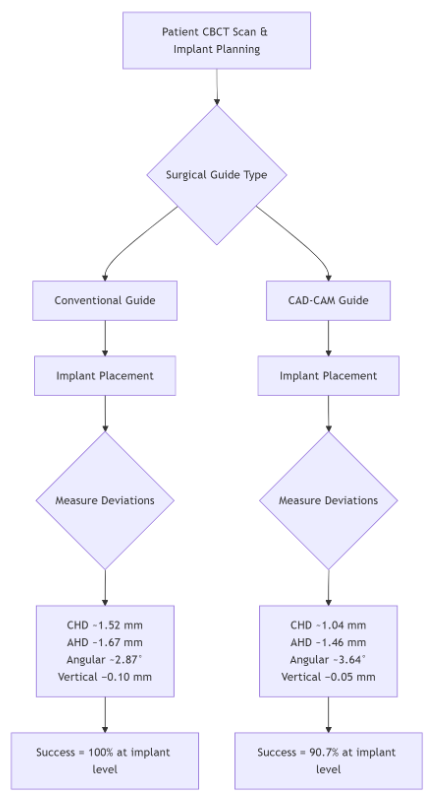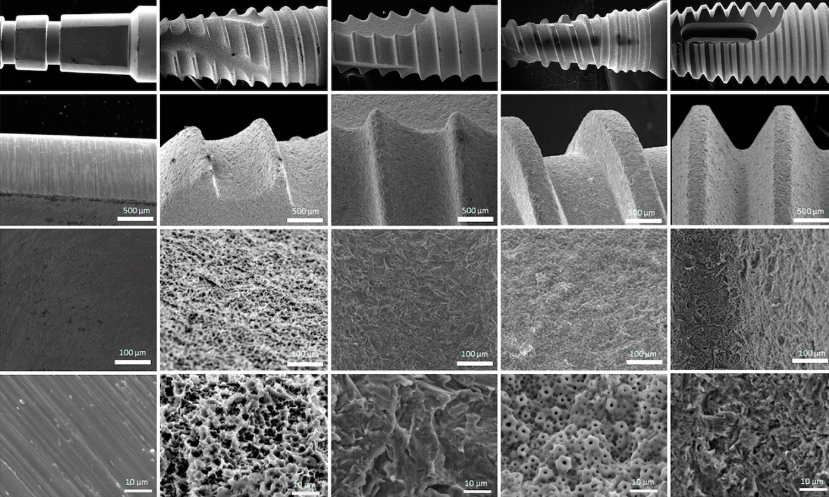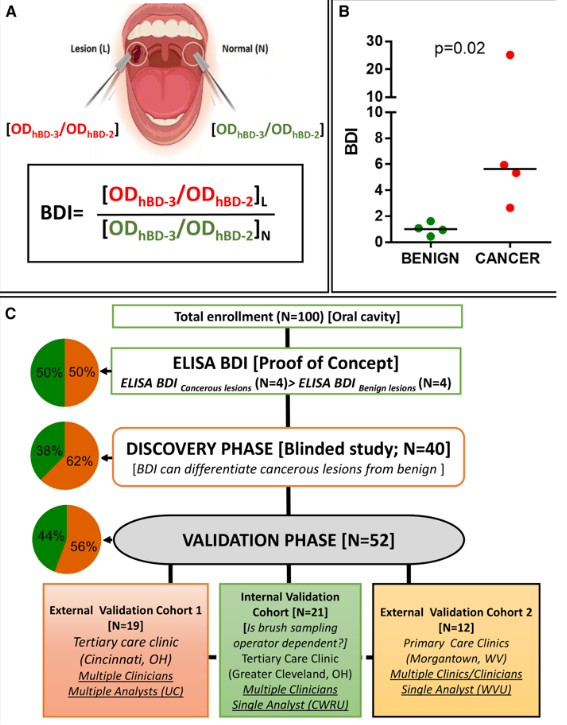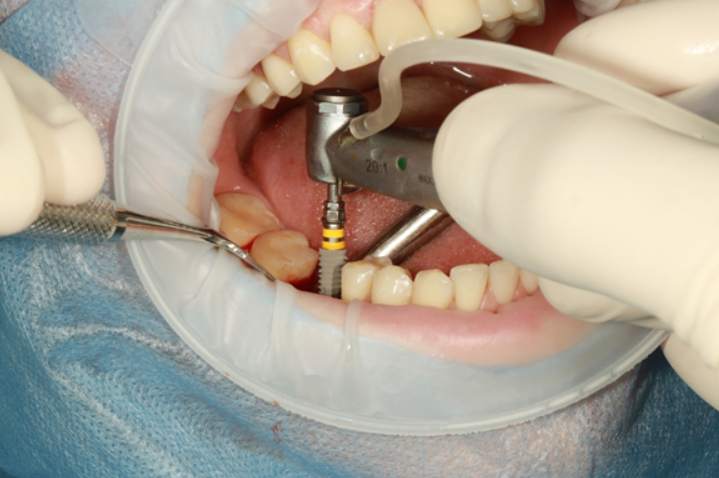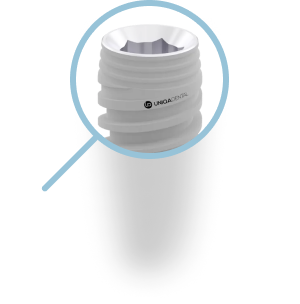Comparison of the accuracy of implant placement using CAD/CAM-manufactured surgical templates and traditional methods
Introduction
Today, we will look at the results of an interesting study published in Clinical Research on Oral Implants (November 23, 2024). The dental community is actively discussing the use of digital technologies, in particular CAD/CAM. The advantages of digitization include high accuracy and reduced time spent on the entire treatment process. However, specialists are not interested in general phrases and assurances, but in specific results with figures. To better understand the role of surgical guides, you may also want to see other implant workflow comparisons.
This study compared the accuracy of implant placement in two groups of patients:
- a fully digital process (sCAIS technology) with surgical templates manufactured using CAD/CAM
- a partially digital process – surgical templates were manufactured in the traditional way based on a physical model of the patient’s jaw
Complex conditions were specifically chosen for the study: implants were placed in the distal sections of the jaws, where there were no adjacent teeth behind them. This meant that the remaining teeth could not be used as a support for fixing the surgical templates.
Twenty-seven patients participated in the study, and a total of 76 implants were placed.
This is a blind quasi-experimental study, and the results obtained are reliable enough to determine whether CAD-CAM technologies provide a measurable difference in the accuracy of placement. The accuracy of implant placement is one of the key factors for long-term stability of the restoration.
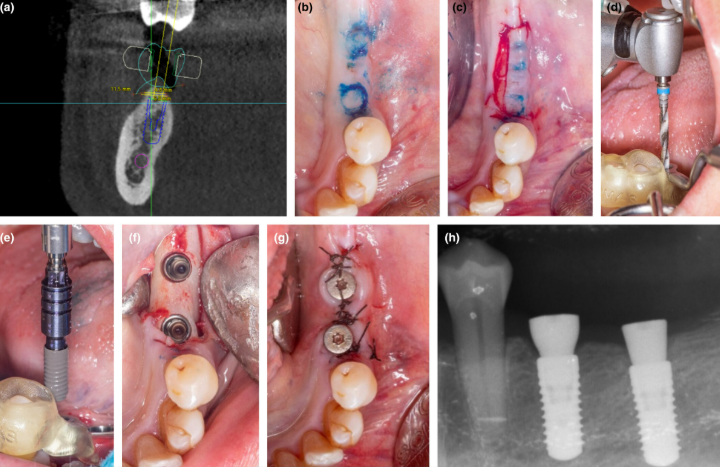
Intraoperative view of implant planification and surgery. (a) Planification. (b) Implant position was marked through the splint. (c) Incision. (d) Drilling. (e) Implant insertion. (f) Postoperative occlusal view. (g) Suture. (h) X-Ray control. Wiley Online Library/ clr.14384/ Garcia-Mira Berta/ November 2024
Key Findings
- Coronal horizontal deviation (CHD): CAD‑CAM group averaged 1.04 mm, significantly less than 1.52 mm in conventional guide group (p = 0.004).
- Apical horizontal deviation (AHD): 1.46 mm (CAD‑CAM) vs 1.67 mm (conventional), not statistically significant.
- Angular deviation: Slightly higher in CAD‑CAM group (3.64° vs 2.87°), but without statistical significance.
- Vertical deviation: −0.05 mm (CAD‑CAM) vs −0.10 mm (conventional); differences were non-significant.
- Implant success rate at one year: 92.1% overall—90.7% in CAD‑CAM group (TG), 100% in conventional group (CG), with significance at the implant level (p = 0.026), though not at the patient level.
Mechanisms & Surgical Workflow
Digital vs. Conventional Guide Production
- CAD‑CAM guides were digitally designed using CBCT images and 3D planning software, enabling precise matching between virtual planning and physical guide.
This step is crucial for achieving optimal results with digital planning using CAD/CAM systems. - Conventional guides, produced via analog methods (likely manual wax-ups or model-based stents), lack this digital alignment and may introduce greater placement variability.
Measurement Metrics
- CHD and AHD assess lateral deviation at coronal and apex levels, respectively.
- Angular deviation quantifies implant tilt relative to planned axis.
- Vertical deviation measures depth placement accuracy.

The coDiagnostix application was used to match the CBCT images obtained pre- and postoperatively, and to compare the locations of axes of the planned and placed implants. (a) CBCT pre- and postoperatively matched with the planification program. (b) Studied variables. Wiley Online Library/ clr.14384/ Garcia-Mira Berta/ November 2024
Factors Influencing Accuracy
Regression modeling revealed:
- Sleeve height: taller sleeves improved CHD/AHD accuracy.
- Premolar vs molar positioning: premolar sites were associated with better accuracy.
- Implant length: shorter implants correlated with improved placement precision.
Implications for Dental Professionals
- Enhanced lateral precision: CAD‑CAM guides offer statistically significant improvement in coronal placement (CHD) compared to conventional guides.
- Careful planning needed: Despite better lateral accuracy, CAD‑CAM group experienced all implant failures in this study, highlighting the importance of surgical and prosthetic planning plus clinical oversight.
- Optimization of guide design: Sleeve height, implant location, and implant length should be carefully considered during digital planning to maximize spatial accuracy. One helpful tool in improving precision is the use of sleeves for MUA in digital workflows.
- Patient‑level outcomes: While implant-level success showed a difference, overall patient outcomes did not significantly diverge, reminding clinicians to interpret device-level improvements in clinical context.
Study Overview & Methods
- Design: Prospective, controlled, blinded quasi‑experimental.
- Sample size: 27 patients with 76 implants (distributed evenly between CAD‑CAM TG and conventional CG).
- Outcome measures:
- Primary – positional deviations: CHD, AHD, angular and vertical deviations.
- Secondary – one-year implant success.
- Analyses: Descriptive metrics (mean, SD, IQR), inferential hypotheses testing, and multivariable linear regression controlling for scalpable confounders like sleeve height, site, and implant length.
Workflow and Key Results
Conclusion
This high‑quality clinical investigation provides evidence that CAD‑CAM–fabricated surgical guides deliver superior coronal placement precision in static guided implant surgery for distal free-edge cases compared to conventional guides. Despite this lateral accuracy improvement, the slightly increased implant failure rate in the CAD‑CAM group underscores the need for comprehensive clinical judgment. Factors such as sleeve height, implant location, and length must be optimized within the digital workflow. For further guidance on choosing the right implant length, see our clinical article on short implants.
Ultimately, integrating CAD‑CAM planning can improve predictability of implant positioning, though clinicians should remain vigilant throughout planning and execution.
Frequently Asked Questions (FAQs)
Q1: What is sCAIS and why is guide accuracy important?
A1: sCAIS (Smart Computer-Assisted Implant Surgery) is a navigation system for surgeons. This technique allows for the most accurate implant placement even in very complex conditions. The technique covers almost all stages, from scanning and planning the operation to manufacturing surgical templates. It allows you to make a surgical template with the highest precision and additional elements for fixation. For example, if there are no supporting teeth, sCAIS can be used to make a bone-supported template that will cause minimal trauma to soft tissues. This means less pain, less swelling, and faster healing. For step-by-step planning protocols, see this detailed article on dental implant surgery procedures.
Q2: Why did the CAD‑CAM group have improved coronal accuracy but lower implant-level success?
A2: While CAD‑CAM guides reduce lateral placement error, implant success also depends on surgical execution, bone quality, peri-implant healing, and patient factors. Guide precision alone cannot offset biological and procedural risks.
Q3: Can sleeve height or implant length be adjusted to improve outcomes?
A3: Yes. Taller sleeves help guide drills more accurately, and shorter implants were associated with better placement precision in this study. Digital planning should consider those parameters for optimal results.
Q4: Should clinicians abandon conventional guides altogether?
A4: Not necessarily. Conventional guides remain reliable if carefully fabricated. CAD‑CAM can offer enhanced placement accuracy, but success depends on holistic clinical planning and execution.
Q5: Are these findings generalizable to other implant sites or workflows?
A5: The study focused on distal free‑end implants. While indicative, further research is necessary across fully edentulous arches, anterior sites, and dynamic navigation or robotic workflows before generalizing broadly.
Sources
Clinical Research on Oral Implants – Prospective Clinical Study on the Accuracy of Static Computer-Assisted Implant Surgery in Patients With Distal Free-End Implants. Conventional Versus CAD-CAM Surgical Guides – November 23 2024
